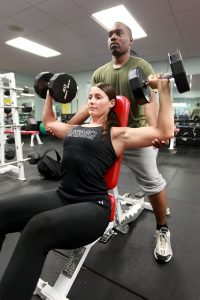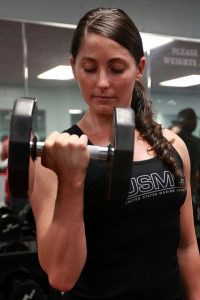You can achieve some pretty amazing things with just 3 days a week in the gym. We’ve tailored our own 3 day a week workout routine to help you pack on lean muscles and lose fat.
This program involves a handful of core exercises which will form the basis of your routine. These are multi-joint, compound exercises that require a lot of calories and that work a number of muscle groups together. They are the best exercises to get you lean.

How This Training Program Works
A unique feature of this program is that it involves alternating between two different workouts every training day. On Day One you do Workout A for your Upper Body and on Day Two you do Workout A for your lower body. The next session you do Workout B for your Upper Body. Not only does this keep your workouts fresh and interesting, you are also able to train your muscles from a variety of angles. This enables you to maximally stimulate the muscle fibers and bring out complete definition. By constantly switching workouts you are also able to keep your body guessing, avoid plateaus and keep moving forward.
Keep in mind that you will be working out with weights 3 times per week, not four. That means that your schedule will follow this pattern:
The program uses a two-day split routine. The body is divided into an upper body day and a lower body day. You train the abs every 2nd workout. (Here’s our Best Ab Workout for Men)
Here are the four workouts that you will perform.
Upper Body Workout A
Decline Dumbbell Row: 4 sets / 8-10 reps
Chin Ups: 3 sets / 8-12 reps
Barbell Bench Press: 4 sets / 4-8 reps
Dumbbell Incline Press: 3 sets / 8-12 reps
Dumbbell Shoulder Press: 3 sets / 4-8 reps
Lying Tricep Extension: 3 sets / 8-12 reps
Standing Supinated Dumbbell Curls: 3 sets / 8-12 reps
Exercise 1: Decline Dumbbell Row
Prime Mover: Latissimus dorsi, center and lower trapezius
Begin by adjusting an incline bench to a low angle, about 20 or 30 degrees. If your gym doesn’t have an adjustable bench, use a regular flat bench and put the rear legs up on a block. Make sure the bench is stable before beginning the exercise.
Lean over the high end of the bench so you’re supporting yourself on your abdominals. To start with, the dumbbells should be slightly in front of you at about a 45-degree angle (like airplane wings). Grip them, palms facing back. Bend your elbows enough so that your shoulder blades travel out as far as they will go. The idea here is to ensure maximum range of motion for your lats and your middle / lower traps.
When you’re in the correct position, you will feel a stretch across your middle back as well as in your lats.
Pull the weights up and back with the lift coming from your lats and traps, not your arms or shoulders. Concentrate on starting the movement by bringing your shoulder blades together and away from your head. As you pull, raise your chest slightly off the bench, but keep your abdominals firmly pressed against the bench to keep the pressure off your lower back. Rotate your wrists so that your palms end up facing one another. Keep your elbows close to your sides. Lift until your elbows are at waist level.
Reverse the motion to lower the weights.
Exercise 2: Chin Ups
Prime Mover: Latissimus dorsi
Grab a chinning bar with an underhand, shoulder width grip, and hang with your elbows slightly bent. Pull your chin up above the bar, hold for a second or two, and lower your body with control. Let your legs hang straight down and don’t jerk your way up. Just pull yourself up in a smooth motion and then let your body down under control.
For maximum stretch and contraction, lower yourself to the very bottom of each rep and pull up until your chin touches or goes above the bar.
Exercise 3: Barbell Bench Press
Prime Mover: Pectorals
Load the appropriate weight onto the bar. Lie on the bench and take a grip just wide enough so your forearms are not quite parallel. Too narrow a grip shifts the load onto the triceps and makes it difficult to feel the tension in the chest. Now pinch your shoulder blades together. Lower the bar to sternum level. Your elbows should end up at a 70 degree angle to your sides and your forearms should be vertical. Touch your chest (never bounce), forcefully stretch your pecs and immediately drive upwards, squeezing your lats and arcing the bar up to its start position at mid chest. Lock out briefly between reps. Keep your shoulders down throughout the movement.
Breathing: Inhale while the bar is overhead, hold your breath during the descent and breathe as your press back.
Exercise 4: Dumbbell Incline Press
Prime Mover: Pectorals
If the incline bench you are using is adjustable, set it to a 30 degree angle. Sit on the bench with a dumbbell in each hand. Rest the dumbbells on your thighs close to your knees. Kick up your legs, one at a time, to assist getting the weights into position up at your shoulders.
Press the dumbbells up, using your pecs to pull them up and across your chest. Keep your back flat against the bench as you lift. At the top of the movement, squeeze the pecs tightly and hunch your shoulders forward. Don’t touch the weight together at the top of the exercise – keep them 2-3 inches apart. Slowly lower the weight down as far as you can, getting the greatest stretch possible.
Exercise 5: Dumbbell Shoulder Press

Prime Mover: Deltoids
Sit on a bench and grasp a pair of dumbbells with a closed, pronated grip. Your head should be up and your upper back and hips should be pressed against the back pad of the seat. Move the dumbbells to position them at shoulder level with your palms facing forward. The dumbbell handles should be in line with each other and parallel to the floor.
Push the dumbbells up until your elbows are fully extended. Keep your wrists straight and directly above your elbows. Make sure, too, that you maintain your erect position. Do not lean back or lift off the bench as you press the dumbbells overhead.
Now lower the dumbbells back to the start position. Keep your wrists straight and directly above your elbows.
Exercise 6: Lying Triceps Extension
Prime Mover: Triceps
Lie on a flat bench with a barbell across your thighs. Position yourself so that the base of your head is against the end of the bench (in other words, so most of your head is off the bench). Grab the barbell with a narrow, palm down grip and kick your legs back to get the bar into position above your head. Your arms should not be straight up and down. Rather, they should be inclined slightly backward and toward the head. This angle keeps tension on the triceps throughout the entire exercise. Bend your knees and hook your feet against the end of the bench.
Starting in this position, lower the bar to your forehead, keeping your forearms parallel to each other and your upper arms stationary. Don’t allow the elbows to drift apart. Non-parallel forearms greatly decrease the effectiveness of the exercise and increase the strain on your elbows.
Press the bar back up to the inclined position. Concentrate on keeping your upper arms parallel.
Exercise 7: Standing Supinated Dumbbell Curls
Prime Mover: Biceps
Begin with a dumbbell in each hand, palms facing forward. You can increase your stability and decrease general strain during this exercise by performing this movement leaning against a bench with your knees slightly bent. Think of the exercise as a combination of two movements that must be smoothly integrated.
The first is supination of the forearm. This involves rotating your forearm so that your palm, which begins facing backward, ends up facing forward.
Second is a curl. Make sure that your elbow and arm remain in the ideal plane throughout the movement (perpendicular to your body). You don’t want your elbows to move away from the body. Contract the biceps strongly at the top of the movement.
Lower Body Workout A
Barbell Squat: 4 sets / 4-8 reps
Farmer’s Walk: 3 sets / 12 reps
Dead-lift: 4 sets / 8-12 reps
Lying Leg Curl: 3 sets / 8-12 reps
Standing Calf Raise: 3 sets / 12 reps
Exercise 1: Squats
Prime Mover: Quadriceps
Place an Olympic bar on the squat rack. At a weight of 45 lbs you won’t need to add any added weight but make sure that use a pad in the middle of the bar to protect your neck.
Position yourself under the bar and lift it off the rack. Step back and stand with your feet spread slightly wider than shoulder width and pointing slightly outward. Keep your back straight, your chest thrust out and your head up. Now tense your abdominal wall, bend you knees and lower your body until your thighs are parallel with the floor. To avoid excess strain on the knees, don’t go down any further. While squatting, keep your head up and your back slightly arched.
In the bottom squat position, your lower legs should be almost vertical to the floor. Push through your heels as you return to the starting position.
Exercise 2: Farmer’s Walk
Prime Mover: Quadriceps
Select a pair of light dumbbells (2 – 5 lbs) and place them in front of you in an area that allows you at least 9 feet of clearance straight ahead. Stand between the dumbbells and bend down to grip the handles. Lift the dumbbells by driving up through your heels while keeping your back straight and your head up. Take an exaggerated step that requires you to lunge. The longer the step the more emphasis is placed on your glutes while shorter steps maximize the effect on the thighs. Pushing off with you forward leg, continue lunge walking until you have covered the set distance.
On this exercise, you’ll perform 3 sets of 12 reps, lunging with both legs for a single repetition.
Exercise 3: Deadlift
Prime Mover: Upper Back
Load a barbell and set it on the floor. Squat in front of it with your feet shoulder width apart. Grab it overhead with your hands just outside your legs, your shoulders over or just behind the bar, your arms straight and your back flat or slightly arched.
Simple as it sounds, all you really do is stand up. The key is to push with your heels and pull the weight to your body as you stand. Pause with the weight, but don’t lean back, then slowly return to the starting position. Pause with the weight on the floor and reset your body over the bar. You defeat the purpose of the dead-lift if you use momentum to knock out the reps.
Exercise 4: Lying Leg Curl
Prime Mover; Hamstrings
Lie on the leg curl machine, hooking your feet under the leg curl bar. Drop your chest down flat against the bench, but keep your head up and your back arched slightly (you will be in the “Sphinx” position). Curl the bar up as high as it will go. If you can’t get it up all the way, decrease the weight. Leg curls are only effective when done with correct form. It’s the tension in the hamstrings that counts, not the weight.
Exercise 5: Standing Calf Raise
Prime Mover: Soleus
Position yourself under a standing calf rise machine, with your shoulders resting on the shoulder pads. Place your toes on the edge of the foot plate and stand to an upright position. Keeping your knees locked throughout the movement, raise up on your toes to fully extend your calves. Hold at the top position for a slow count of three. Now, without bending your knees, lower to stretch your calves downward.
Upper Body Workout B
Decline Dumbbell Row: 3 sets / 8-12 reps, 1 set 20 reps
Lat Pulldowns: 3 sets / 8-12 reps
Barbell Bench Press: 3 sets / 8-12 reps
Incline Dumbbell Flys: 3 sets / 8-12 reps
Dumbbell Shoulder Press: 3 sets / 8-12 reps
Triceps Push-down: 3 sets / 8-12 reps
Incline Dumbbell Curls: 3 sets / 8-12 reps
See Workout A for exercise explanations.

Lower Body Workout B
Barbell Squat: 3 sets / 8-12 reps, 1 set 20 reps
Leg Press: 3 sets / 8-12 reps, 1 set 20 reps
Lying Leg Curl: 3 sets / 8-12 reps
Standing Calf Raise: 3 sets / 15-20 reps
See Workout A for exercise explanations.
A Note on Resistance
Selecting the appropriate weight for each exercise will require a little bit of trial and error. For the first two weeks of the program your focus should be on training your body in correct exercise technique and performance. The resistance, therefore, can be a little lighter than optimum until you are in the groove of the movement. For compound exercises such as squats, dead-lifts and bench presses you can start with just an Olympic bar. Movements that isolate the smaller muscles groups (such as lateral raises and flys) don’t require that much weight to be effective. After a couple of weeks, apply the guidelines already provided on choosing resistance (i.e. the last 2-3 reps should be the most you could do at that weight).